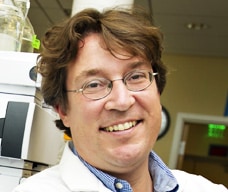Doctor Oliver Fiehn
Charting Unexplored TerritoryAgilent helps researchers understand the intricacies of metabolomicsThe field of metabolomics is still, in many ways, unexplored territory. Consider, for example, E. coli, perhaps the best studied organism on the planet. "Even for that organism, 50 percent of the enzymes do not have an annotated function," says Dr. Oliver Fiehn. "We know they are working on metabolism, we just don't know what exactly are they doing?" As the Director of the West Coast Metabolomics Center at the University of California at Davis, Fiehn knows that he and his fellow researchers—there, and around the world—have their work cut out for them. "So what about humans?" he asks. "We have trillions of microbial cells living with us and, of course, our own metabolism." Fiehn and his team at UC Davis are finding answers with the help of instruments from Agilent, including state-of-the-art mass spectrometers working in tandem with cutting-edge gas and liquid chromatography systems.
"Our laboratory is committed to understanding metabolism on a comprehensive scale," Fiehn says. "We develop informatics tools, and we apply novel types of separation and mass spectrometry to get a very broad view of what is going on in biological systems." The end game is twofold, he says. One is understanding the mechanisms of nature; the other is translating that knowledge into early diagnostic tests for various human diseases. "Mass spectrometers like the ones from Agilent—the GC/MS as well as the LC/MS systems—get ever-better in terms of sensitivity and the ability to see signals that can be applied to biomedical research, like predicting who will get a heart attack in the next two years or two months," he says. Fiehn believes that the research he and others are doing will someday lead to early and very specific diagnoses. "The only way to do that is by being able to understand the complexity of everything you will find in, for example, blood plasma. It will never be only one biomarker. There won't be one molecule that indicates, very specifically, a certain type of cancer. Rather it will be a pattern and require pattern recognition."
Fiehn and others are laying the groundwork by gathering as much mass spectral data as possible and putting it into databases that the scientific community can access—either freely in the case of government-funded research, or for a fee in the case of company-funded work like the Fiehn-Agilent GC/MS libraries. "Last year, we published LipidBlast, a database of 200,000 mass spectra of complex and neutral lipids, representing 29 lipid classes," he says. Fiehn acknowledges, however, that it's just a start. "While there is primary metabolism—that is, sugars, amino acids, and hydroxyl acids that are commonly found in many species—the real diversity in small molecules comes from the plethora of terpenoids, lipids, flavonoids, or phenol-derived compounds, which are so abundant and so manifold that no single laboratory and no single library can have all of them," Fiehn says. "So we need to predict the spectra. If we really want to understand nature, we have to be able to predict mass spectra. That is something that is a years-long undertaking that we have started together with the community at large. We are grateful when Agilent and others support these efforts." To make such predictions, scientists draw on existing data and first principles of physics. "Once you know how specific molecules fragment, you can make chemical scaffolds in the computer and say, ‘OK, so let's imagine instead of this acyl chain we have a longer acyl chain, or instead of this molecule we have the methylated variant of the molecule. How would that affect the mass spectra in terms of the ions you see and in terms of abundances?'" he says. "The more mass spectra of known compounds we have, the better this model building."
|

Oliver Fiehn, Ph.D.
Professor, Department of Molecular and Cellular Biology & Genome Center |
Selected publications
|
Software Tools and Approaches for Compound Identification of LC-MS/MS Data in Metabolomics. Increasing Compound Identification Rates in Untargeted Lipidomics Research with Liquid Chromatography Drift Time-Ion Mobility Mass Spectrometry. Diversity of Neuropeptide Cell-Cell Signaling Molecules Generated by Proteolytic Processing Revealed by Neuropeptidomics Mass Spectrometry. LC-MS-Based Lipidomics and Automated Identification of Lipids Using the LipidBlast In-Silico MS/MS Library. Using Accurate Mass Gas Chromatography-Mass Spectrometry with the MINE Database for Epimetabolite Annotation. Metabolomic characteristics of cholesterol-induced non-obese nonalcoholic fatty liver disease in mice. |